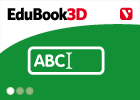Cargando...
Recursos educativos
-
Nivel educativo
-
Competencias
-
Tipología
-
Idioma
-
Tipo de medio
-
Tipo de actividad
-
Destinatarios
-
Tipo de audiencia
-
Creador
Lo más buscado
- La península Ibérica en la Antigüedad
- Adjetivos literarios
- Juegos geográficos
- actividades matemáticas
- Juegos de tablas de multiplicar
- Canciones en inglés
- Mapa de Europa
- Edgar Allan Poe
- Múltiplos de 4
- Dictados para primaria
- Nutrición infantil
- Actividades de lenguaje
- Repaso de fracciones
- Lobos
- Paraules amb x
-

Artificial reproduction
EduBook Organización
- 2777 visitas
Humans can use asexual reproduction to artificially grow large numbers of plants. Two methods of artificial plant reproduction are cutting and grafting. Cutting is the process of cutting off bits of…
-

Check what I know
EduBook Organización
- 1 lo usan
- 2508 visitas
Answer true or false: The physical environment consists of living things. → There are four important elements in the physical environment. → The air contains minerals. → Plants need…
-

Correct. Summarising concepts
EduBook Organización
- 2638 visitas
Correct the sentences below: The acidity of the soil is determined by the size of its particles that affects its ability to retain water. Irrigated farming only uses rainwater. Subsistence livestock…
-

Check. The transport of substances in plants
EduBook Organización
- 2594 visitas
Remember what you have studied in this section and answer the questions: Talk to a classmate about sap: Draw a diagram to show the plant parts and system involved in transporting water from the soil up…
-

-

The leaves make the food
EduBook Organización
- 2414 visitas
The roots absorb water and minerals from the soil. This becomes raw sap. The raw sap moves up the stem to the leaves. The leaves use raw sap, sunlight and a gas called carbon dioxide to make food. The…
-

Think about it. Abiotic factors
EduBook Organización
- 2367 visitas
Remember what you have studied in this section and answer the questions: Why do you think life developed in water before it developed on land? Light is very important for which organisms? How does light…
-

Choose. Lichens
EduBook Organización
- 2079 visitas
Decide which of the following statements refer to lichens: They are only found in areas where there is very little pollution. They are part of the Plant kingdom. They are eaten by some small animals,…
-

Unit 7: Agriculture, livestock and fishing
EduBook Organización
- 1820 visitas
Aquaculture (n): an activity that consists of farming marine animals and plants in pools, ponds or enclosed areas of the coast. crop rotation (n): the practice of growing different types of crops in the…
-

Fertilisers
EduBook Organización
- 1481 visitas
Fertilisers are mixtures of chemical substances, including many biolelements. They are used to enrich the soil and improve plant growth. They usually contain nitrogen, phosphorus, potassium and…
Te estamos redirigiendo a la ficha del libro...













